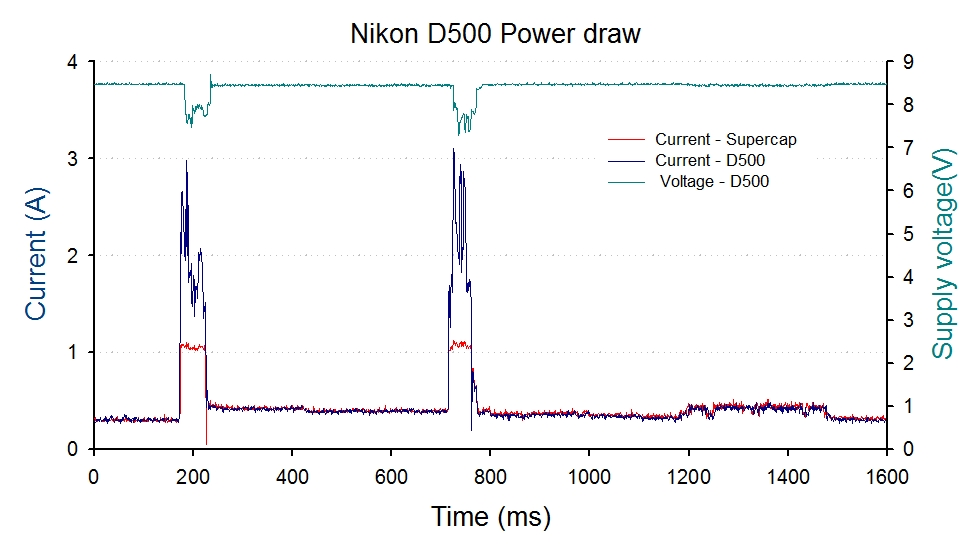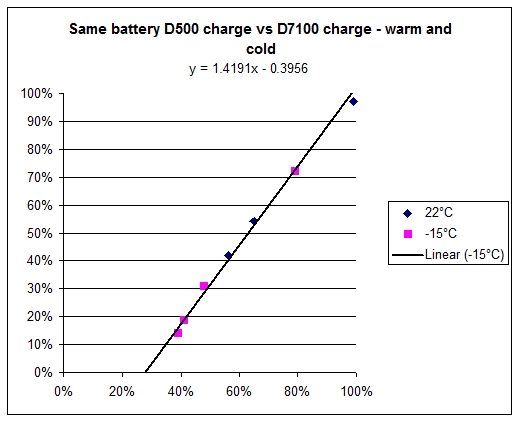An analysis of the D500 power consumption: The peak current draw of the D500 is even higher than the D7100, exceeding 3A. However the final version of the super capacitor circuit nicely caps the current draw from the DC-DC converter at ca. 1A. This curve is with the Nikon 12-24mm mounted, so a worst case scenario (see below) rather than minimum current draw without lens:

Blue line current draw by D500, red line current draw from DC-DC converter, teal line voltage supply to D500.
The 8.5 V supply in idle mode of the D500 registers at 98-100% battery power. The voltage dip is partly due to that I am passing the supply though the 0.1 Ohm resistor I use to measure the current draw, and does not affect the battery state display. Another reason is voltage drop over the diodes, about 0.25V per diode and increasing somewhat with the current draw. This voltage drop is partly by design, as it will help draw current from the super capacitor rather than the power bank.
Here is a chart comparing static types of current draw by D5100, D7100 and D500. Each state was measured over several seconds with a highly accurate voltage meter.

While the D5100 generally use draws little more than 2/3 of that of D7100, what is striking is the minimal % increase in current draw of D500 over D7100, generally in the 2-8% range. The exceptions are Live view
exposure where the screen back light stays on with D500 opposed to D7100. The latter draws about the same current during live view exposure as one in viewfinder mode. Also video recording use a little more on D500, however I had digital image stabilization turned on in D500. Image review with paging though frames as fast as possible also is higher, which could be due to D500 being able to page though images faster, perhaps in combination with higher display resolution.
Using high ISO has no effect on current draw during a 30 second exposure. I also tried longer exposures and turned High ISO noise reduction on and off, but there was no difference. so Peter, your shorter battery life at long exposures and high ISO mentioned on page 1 seems to have other causes.
If AFS lenses are attached, current draw even when idle might increase 30-40%, however active VR is only a 10% increase in the 300PF, about the same as continuous AF operation. The 12-24mm has higher idle current draw but uses little extra during continuous AF operation. My custom chipped 55mm f/3.5 micro did not draw any measurable power compared to my second non-chipped copy. (It likely just powers up to communicate when mounted).
There is a tiny bit of identical current draw in standby mode and with the power switch off. It is a respectable 167 uA (mikro Ampere) in D500, considering that both the top display and the viewfinder mask both receive power. In the D5100 the standby/off state draws almost 1mA, which could drain the battery in 47 days.
If we integrate the curve of the shutter actuation (one with the 55 micro used as base) it is possible to calculate how much extra power a short exposure need in Ampere-seconds, and set up a budget of current drawn based on the above table.

In this particular calculation I have assumed that the camera stays on for 15 sec at each use. D500 cuts power when battery reports 25% in D7100 (see below), so this must be taken into account with respect to which capacity is available.
It is clear that what costs power is not the shutter actuations, which is only a minor fraction, but how long the camera stays on on each use. Also when the D500 is new, and one sit down learning and setting up the menus, one could run the battery down in about 5 hours (How time flies...). So what has been said about mirror-less cameras is also true for DSLRs. (Increase on-time per use to 60 seconds, and the frames per charge will go down dramatically.) Nikon must be taking some liberties when calculating CIPA standard exposures (which is a fairly loose standard). The camera is supposed to stay on for 30 sec for each exposure with screen on, while my calculations will result in the specified 1240 exposures if I set on time per exposure to 21.5 sec and no live view.
A comparison of the battery reporting in D7100 and D500 (inserting the same battery at different charge levels in both) reveals an almost linear relationship between the two, and independent of battery temperature. D500 seems to be more picky on cutoff voltage and will report empty when D7100 reports around 25% charge left. Note that this graph is just a battery meter test and does not imply that D500 use more
average power. But the chosen voltage cutoff level might be a consequence of the need to sustain peak current draw. Keep in mind that the single digit series with the same frame rate use a battery with higher voltage. Previous bodies needed a battery grip to achieve this high frame rate while D500 can do without it.

I also let batteries at two different charge levels cool down for several hours outside before quickly inserting them into D500 and D7100 to check reported battery level:

The reported charge levels by the battery meters show a nice slow decline down to about -20°C, but then the capacity start to drop off more abruptly. The conclusion is that one should go out with battery fully charged at these temperatures, and not expect to have more than 50% capacity available. It remains to be seen how the D500 will perform below -30°C. The situation might be better than this chart indicates, as the camera usually stays in an insulated bag and takes time to cool down. And in very active use the camera will heat itself too, and might not reach ambient temperature.